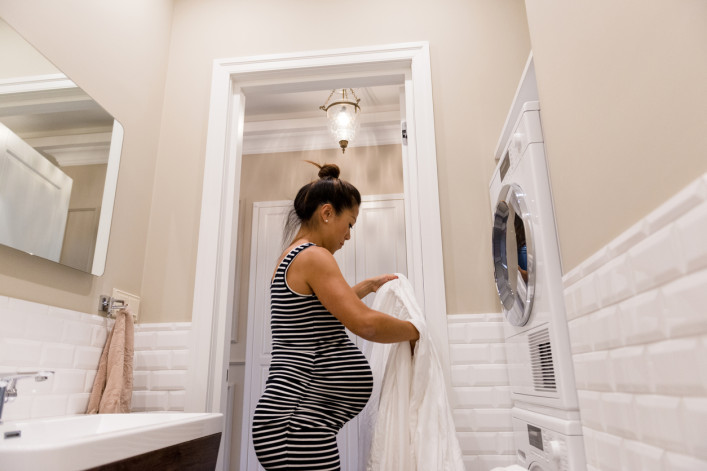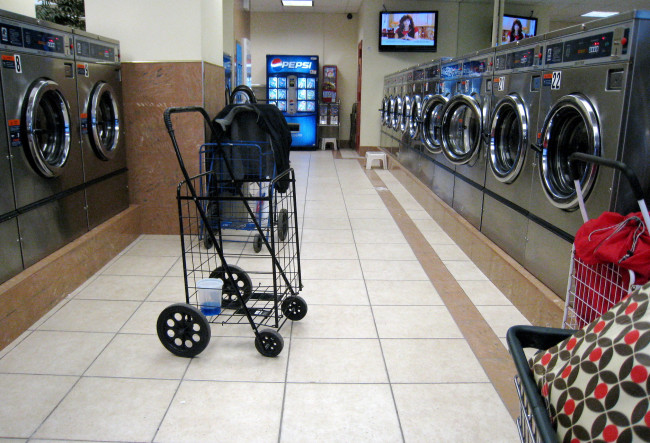You landed an apartment with your own washer and dryer! Here's how to maintain them
- Install a drain pan underneath your washing machine to prevent overflows from a broken hose
- Hire a cleaning company once a year to vacuum the dryer exhaust vent and remove lint build up

If you haven’t had your own laundry machines before, you may be surprised by just how much maintenance is required.
iStock
Congrats! You landed an apartment with an amenity coveted by many New York City renters: Your very own washer and dryer! Cue The Jeffersons’ theme song and do a happy dance, because you won’t be hanging out in a basement laundry room or hauling your stuff to the laundromat anymore.
But hang on a minute—just because these are cleaning appliances doesn’t mean they clean themselves. In fact, if you haven’t had your own laundry machines before, you may be surprised by just how much maintenance is required.
Read on to know what you need to do to stay on top of your own washer and dryer.
[Editor's note: A previous version of the article ran in November 2020. We are presenting it again with updated information for April 2024.]
1) The lint trap needs to be cleaned with every dryer load
My 83-year-old father once called me to tell me he vacuumed a football-size ball of lint out of the duct that leads from his dryer to the vent in the side of his house. Dryer lint is highly flammable and to get that much lint probably took decades. (“Umm, great news, Dad?!”)
So don’t take chances by letting lint build up. Get in the habit of cleaning the lint trap every time you run a load in the dryer.
And every year either you (or your landlord if you rent) will need to have the exhaust vent vacuumed out by professional cleaners. You can band together with other apartments to have your whole building done at the same time. When I lived in a self-managed condo–we did this every year on a Saturday morning.
I recently booked a dryer vent cleaning with Best Cleaning 4 U and it was a piece of cake. The dryer in my rental is on the second floor and the duct snakes about 25 feet, with twists and turns, to a vent on the roof. The cost for cleaning was $250 and it only took about 20 minutes. Two workers brought a heavy duty vacuum and bunch of attachments that they snaked into the ductwork. One worker climbed up on the roof to clean the vent opening—and this was a nice touch—he offered to clean the leaves out of the gutter while he was up there. For that I gave him an extra $20.
Another tip is to create a second lint trap in the hose leading from the dryer. You will need to cut a section of the duct out and add something like this in the cutaway section. I have one and clean it each time I use the dryer—it's pretty easy to do.
The workers who cleaned the duct suggested we have an exhaust fan installed on the roof end of the duct to pull lint out of the system. They said when you have a long duct, the dryer's exhaust system is not strong enough to blow all the lint up and out through the vent in the roof, and once the dryer cycle ends, the lint falls back down the duct and accumulates near the dryer.
Many newer machines will automatically shut down in the event of a fire, and while fire is a concern, it is a rare occurrence.
2) Flooding is a concern
A drain pan underneath your washing machine is crucial to preventing the overflows from a broken hose, which can cause gallons of water to spill—and create a very expensive mess. These are inexpensive and relatively easy for a professional to install (or you, if you’re feeling handy). They are especially necessary if you live above another renters, which is invariably the case in a NYC apartment.
If you don’t have one, you’re probably googling it now, and wondering how this flat pan with a one- or two-inch lip can do much to prevent a flood. It’s simple: Drain pans work because they are connected to a drain pipe—in some cases you may need to hire a plumber to make a connection to a drain pipe.
Some other tips for preventing mishaps are not to run either appliance while you are out of your apartment (or while you’re asleep) so you can spring into action and shut off water or reach for a fire extinguisher in a worst-case scenario. And you should keep a fire extinguisher near your dryer.
3) Mold is your enemy
The newest washing machines are typically front loaders—that’s because they’re designed to wash clothes more efficiently. They’re more effective because the drum rotates on its side—that means you don’t need to fill them with as much water as a top loader in order to spin your clothes through the water.
It's best to only use high-efficiency (HE) detergent in HE machines because regular detergent is too sudsy and will leave behind soap scum. Skip the fabric softener too—it leaves too much residue. You want to avoid using too much detergent in general.
Some washing machine models have a clean cycle and you can run this every month or every 50 loads. If your washer doesn't have a clean cycle, you can run a hot-water cycle and use some kind of cleaner, such as a small amount of bleach or Tide Washing Machine Cleaner.
Front-loading machines have a heavy rubber gasket on the door to prevent leaks—and the folds of the gasket are a prime place for dirt and soap scum to get trapped and create a breeding ground for bad-smelling mold. You can dampen a cloth lightly with white vinegar and wipe the gasket—doing this once or twice a month can combat mildew and keep the stink away.
Make it a habit to leave the door to the washing machine open after every wash to improve air circulation and dry out the machine (if you have a light in your machine, it will shut off after a few minutes).
And do yourself a favor and take your wet clothes out of the washer as soon as the cycle ends—that's one of the easiest ways to avoid mold.
You Might Also Like


























